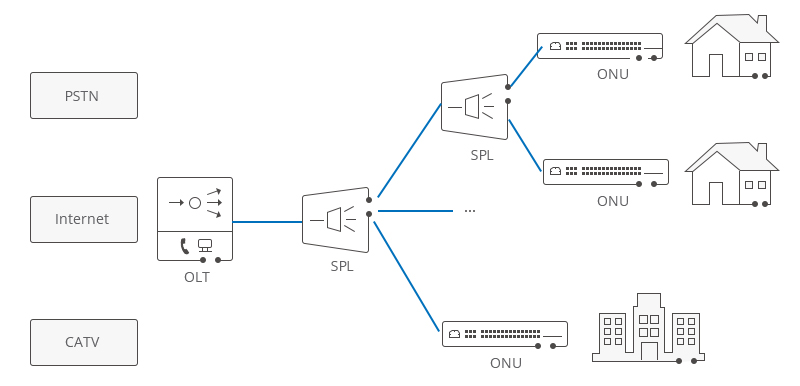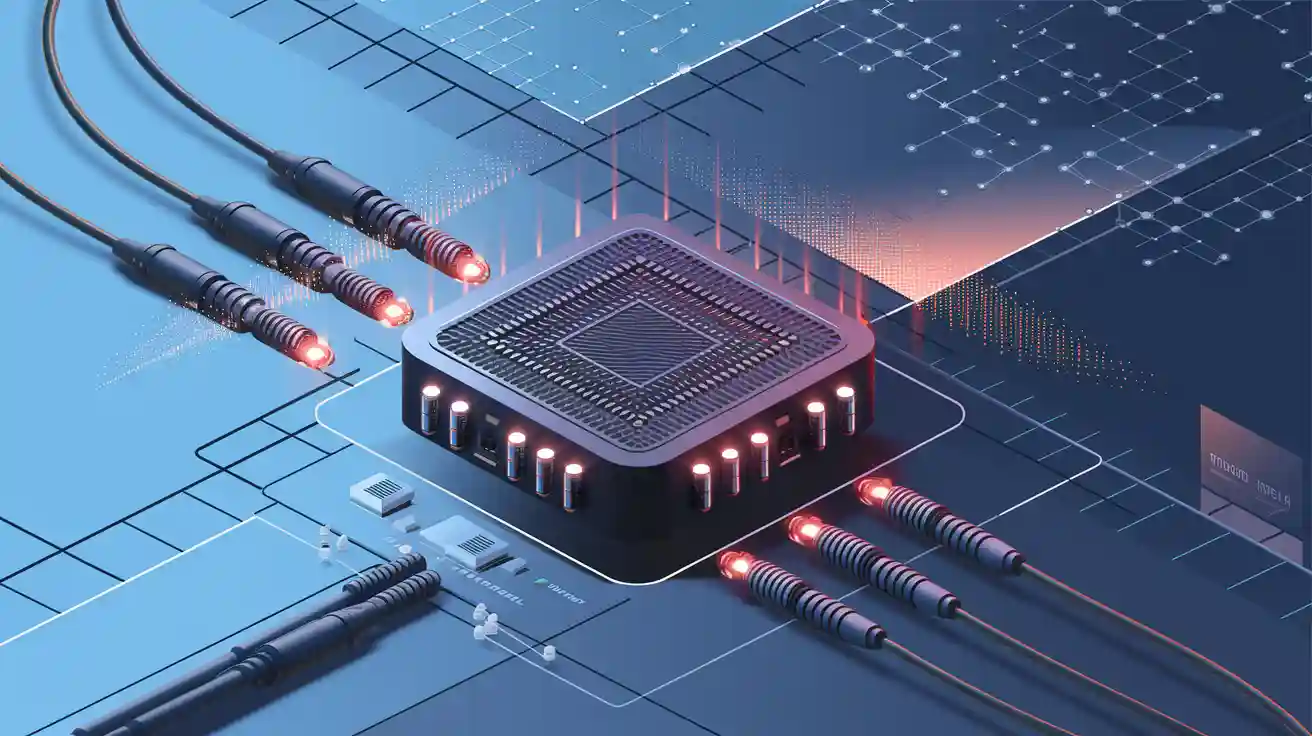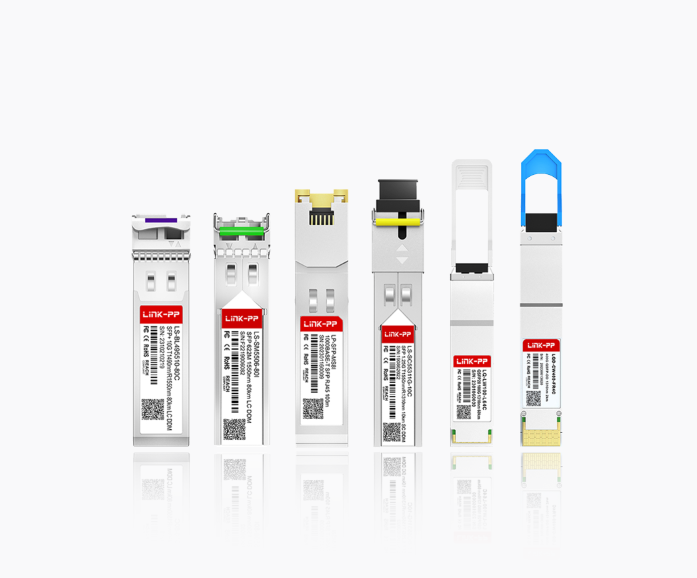
In the relentless drive towards faster, more reliable broadband, Passive Optical Networks (PON) stand as the cornerstone of modern Fiber-to-the-Home (FTTH) deployments. At the heart of every PON system lies a critical, yet often overlooked component: the PON module. This specialized optical transceiver acts as the essential interface converting electrical signals from service provider equipment into the light pulses that travel over fiber optic cables to your home or business. Understanding PON modules is key to grasping the efficiency and scalability of today's broadband networks. Whether you're deploying, upgrading, or optimizing your network, choosing the right PON SFP module or PON SFP+ transceiver is paramount.
Key Takeaways
PON modules work without needing extra power. This saves energy and lowers repair costs.
Picking the right PON module is very important. Think about the package, device type, and standards for best results.
PON technology sends data far distances. For instance, GPON modules send data up to 20 km with fast speeds.
Matching PON modules to your network is important. Make sure it fits your devices' protocol, connector, and wavelength.
PON modules can grow with your needs. They let many users share one fiber, saving money as networks grow.
What is a PON Module?
A PON module is an optical transceiver specifically designed for Passive Optical Network applications. Unlike active optical components requiring power, PON leverages passive splitters, making the modules in the Optical Line Terminal (OLT) at the provider's end and the Optical Network Unit (ONU) or Optical Network Terminal (ONT) at the customer's end crucial active elements. These modules handle:
Electrical-to-Optical (E-O) Conversion: Transforming data from the OLT's electrical interface into optical signals for transmission downstream.
Optical-to-Electrical (O-E) Conversion: Transforming incoming upstream optical signals from ONUs/ONTs back into electrical data for the OLT.
Wavelength Management: Adhering strictly to PON standards (like GPON, XG-PON) that define specific wavelengths for upstream (1310nm/1270nm) and downstream (1490nm/1577nm) traffic, often coexisting with a third wavelength for video (1550nm or 1610nm).
Burst Mode Reception (Upstream): Critically, OLT modules must handle asynchronous upstream transmissions from multiple ONUs, requiring sophisticated burst-mode receivers to quickly detect and synchronize with signals arriving at varying power levels.
How PON Modules Work: The Core Principles

Understanding the fundamental operation of PON modules reveals the elegance and complexity behind PON technology. It hinges on Wavelength Division Multiplexing (WDM) and sophisticated Time Division Multiple Access (TDMA) protocols:
Downstream Transmission (OLT -> ONUs):
Broadcast Nature: The OLT PON module (e.g., GPON OLT SFP transceiver) continuously transmits downstream data as optical signals using a specific downstream wavelength (e.g., 1490nm for GPON, 1577nm for XG(S)-PON).
Passive Splitting: This downstream light signal travels along a single fiber to a passive optical splitter. The splitter divides the optical power, broadcasting the same downstream signal to all ONUs/ONTs connected to its branches.
ONU Reception: Each ONU/ONT PON module (e.g., GPON ONU SFP module) is constantly listening on the downstream wavelength. It receives the broadcast signal, but only processes data packets specifically addressed to it (based on unique identifiers), discarding packets meant for other ONUs. This is akin to everyone receiving the same mail, but only opening envelopes addressed to them.
Upstream Transmission (ONUs -> OLT):
TDMA - The Key to Sharing: Upstream transmission is fundamentally different. All ONUs share the same upstream wavelength (e.g., 1310nm for GPON, 1270nm for XG(S)-PON) on the same fiber strand back to the OLT. To prevent chaotic collisions, PON uses Time Division Multiple Access (TDMA).
OLT Control & Grants: The OLT is the master controller. It assigns specific, non-overlapping time slots to each ONU for upstream transmission. This assignment is communicated to the ONUs via Grants sent in the downstream channel.
Burst Mode Transmission (ONU): When an ONU's assigned time slot arrives, its PON module rapidly switches on its laser transmitter and sends its data packet in a concentrated burst of light at the upstream wavelength. It must precisely control the timing and power level of its burst according to the OLT's instructions.
Burst Mode Reception (OLT - The Critical Challenge): The OLT's PON module faces the most demanding task. It receives these tightly packed, asynchronous bursts of light from multiple ONUs, arriving at significantly different power levels (due to varying distances from the OLT) and with no gaps in between. Its receiver must:
Rapidly Detect: Instantly recognize the start of each new burst from a different ONU.
Synchronize Clock: Recover the clock and data timing for each burst within nanoseconds.
Adjust Gain: Compensate for the large, dynamic range of received optical power.
Low Noise & High Sensitivity: Accurately convert the weak optical signal from distant ONUs into clean electrical data with minimal errors (low BER).
Wavelength Division Multiplexing (WDM): The use of distinct downstream and upstream wavelengths (and often a third for video) allows bidirectional communication over a single fiber strand without interference. The optical transceiver modules contain precise filters to separate these wavelengths.
Visualizing the Flow:
Direction | Source Module | Wavelength | Traffic Type | Key Module Functionality | Network Element Role |
|---|---|---|---|---|---|
Downstream | OLT PON Module | e.g., 1490nm, 1578nm | Continuous Broadcast | E-O Conversion, Precise Laser Control | Master Controller |
Upstream | ONU/ONT PON Module | e.g., 1310nm, 1270nm | Burst Mode (TDMA) | Burst E-O Conversion, Precise Timing | Slave (Grant-Driven) |
Upstream Rx | OLT PON Module | e.g., 1310nm, 1270nm | Burst Reception | High-Speed O-E Conversion, Burst Clock/Data Recovery, Dynamic Gain Adjustment | Master Receiver |
Types of PON Modules
Understanding the types of PON modules helps you choose the right solution for your fiber-optic network. These modules are classified based on package type, device type, and technical standards.
1. By PON Standard/Generation:
This is the primary classification, dictating fundamental performance characteristics and compatibility.
PON Standard | Downstream Speed | Upstream Speed | Downstream Wavelength | Upstream Wavelength | Common Module Form Factor | Key Application Era |
|---|---|---|---|---|---|---|
GPON | 2.488 Gbps | 1.244 Gbps | 1490 nm | 1310 nm | SFP (Class B+, C+, C++) | Dominant Current FTTH |
XG-PON | 9.953 Gbps | 2.488 Gbps | 1578 nm | 1270 nm | SFP+ (N1, N2a, N2b) | Growing 10G FTTH/B |
XGS-PON | 9.953 Gbps | 9.953 Gbps | 1578 nm | 1270 nm | SFP+ (N1, N2a, N2b) | Symmetric 10G Demand |
NG-PON2 | Up to 40 Gbps (Aggregate) | Up to 40 Gbps (Aggregate) | Tunable (C-Band) | Tunable (C-Band) | SFP+, QSFP+ (More Complex) | Future-Proof / High Density |
GPON (Gigabit PON): The most widely deployed standard globally. Uses SFP form factor modules (often called GPON OLT SFP or GPON ONU SFP). Key variants are Class B+ (common), C+, and C++ offering increasing optical power budgets for longer reach or more splits. Looking for reliable GPON SFP transceivers? LINK-PP offers a full range of certified, high-performance options. Contact us now>>>
XG-PON (10 Gigabit PON): Offers 10G downstream. Coexists with GPON on the same fiber using different wavelengths (WDM). Primarily uses SFP+ form factor modules.
XGS-PON (10 Gigabit Symmetric PON): Provides symmetric 10G upstream and downstream, increasingly popular for business services and future-proofing. Also uses SFP+ modules.
NG-PON2 (Next-Gen PON 2): Utilizes Time and Wavelength Division Multiplexing (TWDM) with tunable lasers to deliver up to 40G aggregate bandwidth (4 x 10G channels). Requires more advanced, tunable modules. Represents the cutting edge.
2. By Location/Function:
OLT PON Module: Resides in the service provider's central office or cabinet. Transmits continuous mode downstream and receives burst mode upstream. Requires higher sensitivity burst-mode receivers. (e.g., GPON OLT SFP transceiver).
ONU/ONT PON Module: Resides at the customer premises. Transmits burst mode upstream and receives continuous mode downstream. Simpler transmitter/receiver requirements compared to OLT modules. (e.g., GPON ONU SFP module).
3. By Optical Power Budget (Class):
Defines the link's maximum allowable optical loss (reach and split ratio capability). Higher class = higher power = longer reach or more splits.
GPON: Class B+ (28dB), Class C+ (32dB), Class C++ (35dB+).
XG(S)-PON: N1 (29dB), N2 (31dB), often with sub-classes like N2a (31dB) and N2b (35dB+).
4. By Form Factor:
SFP (Small Form-factor Pluggable): Dominant for GPON OLTs and all ONU/ONTs. Hot-pluggable.
SFP+ (Enhanced Small Form-factor Pluggable): Used for XG-PON, XGS-PON, and some NG-PON2 OLTs. Same size as SFP but supports 10G speeds.
Other (QSFP+, etc.): Emerging for higher-density or aggregate solutions like NG-PON2.
Key Advantages & Features of Modern PON Modules
High Bandwidth & Scalability: Enable multi-gigabit and 10G services to homes and businesses, easily scalable by upgrading modules at the OLT or ONT.
Long Reach: Support distances up to 20km (or more with higher classes like C++/N2b) from central office to customer.
High Split Ratios: Allow a single OLT port to serve 64, 128, or even 256 end-users via passive splitters, dramatically reducing fiber infrastructure costs.
Low Latency: Essential for real-time applications like gaming, video conferencing, and financial transactions.
Energy Efficiency: PON architecture itself is passive, and modern modules are designed for lower power consumption per bit compared to older technologies.
Reliability & Stability: Designed for carrier-grade operation in demanding environments (temperature variations, continuous operation). High-quality components ensure low Bit Error Rates (BER).
Standardization & Interoperability: Adherence to MSA (Multi-Source Agreement) and PON standards (ITU-T G.984, G.987, G.9807, G.989) ensures compatibility between OLTs and ONTs from different vendors when using compliant modules.
Hot-Pluggability: SFP/SFP+ form factors allow for easy installation, replacement, and upgrades without disrupting other services.
Primary Application of PON Modules
FTTH / FTTP (Fiber-to-the-Home/Premises): The core application, delivering high-speed internet, voice (VoIP), and video (IPTV or RF overlay) to residential customers. Reliable GPON optical modules are fundamental to mass-market FTTH deployments.
FTTB / FTTdp (Fiber-to-the-Building / Distribution Point): Serving multi-dwelling units (MDUs), office buildings, or curb-side cabinets, with final distribution via existing copper (VDSL2, G.fast) or Ethernet.
Business Services: Delivering dedicated, high-bandwidth, symmetric connections (especially using XGS-PON) to enterprises, schools, hospitals, and government buildings.
Cable TV (CATV) Overlay: Utilizing the 1550nm/1610nm wavelength to deliver traditional RF video services alongside data on the same fiber.
Conclusion
PON modules have revolutionized the way fiber networks operate. Their classifications by package type, device type, and technical standards offer flexibility for diverse applications. Features like passive operation, wide temperature ranges, and high transmission distances make them indispensable for modern access networks. With GPON and EPON systems delivering 2.5 Gb/s and 10-Gb/s PON systems already in deployment, the upcoming 50-Gb/s PON standard promises even greater capacity and performance.
This technology minimizes fiber runs and eliminates power needs at transmission points, enabling cost-effective fiber-to-the-home solutions. Applications like ultra-high-definition TV, online gaming, and smart home systems benefit from PON’s scalability and efficiency. By adopting PON modules, you can build a robust access network that meets the growing demand for high-speed connectivity.
Ready to Optimize Your PON Deployment?
Don't let subpar optical transceivers become the bottleneck in your high-speed network. LINK-PP delivers a comprehensive portfolio of rigorously tested, MSA-compliant, and carrier-certified PON modules, including:
High-performance GPON SFP transceivers (OLT & ONU, Class B+/C+/C++)
Future-proof XGS-PON SFP+ modules (OLT & ONU, N1/N2)
Reliable solutions for all major OLT platforms
FAQ
What is the main advantage of using PON modules over traditional optical modules?
PON modules operate passively, which means they don’t need external power between the central office and the end-user. This design reduces energy consumption and maintenance costs, making them more efficient and cost-effective for residential and small-scale networks.
Can PON modules support long-distance data transmission?
Yes, PON modules can transmit data over long distances. For example, GPON modules support up to 20 km, while XGS-PON modules can achieve similar distances with higher bandwidth. This makes them ideal for both urban and rural deployments.
Are PON modules compatible with all network devices?
Not all PON modules are universally compatible. You need to check the module’s protocol (e.g., GPON or EPON), connector type, and wavelength support to ensure it matches your network devices like OLTs, ONUs, or ONTs. Compatibility ensures seamless communication and optimal performance.
What factors should you consider when selecting a PON module?
You should evaluate the module’s transmission protocol, operating temperature range, interface type, and compatibility with your existing devices. Additionally, consider the bandwidth and distance requirements of your network to choose the most suitable module.
How do PON modules handle scalability?
PON modules use optical splitters to serve multiple users with a single fiber. This design allows you to expand your network without significant additional costs.
See Also
Understanding TOSA in Optical Modules and Its Significance




